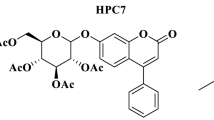Abstract
Purpose
Due to serious problems with the treatment of leishmaniasis all around the world, here is an urgent need in the search for new drugs that are more effective and safer for the treatment of the various forms of leishmaniasis. Actual therapy is limited and lacks sufficient efficacy due to incomplete elimination of the parasites form of patients. In this sense, we decided to evaluate, by first-time, a series of seventeen camphor hydrazone derivatives (2a–2p) against Leishmania amazonensis.
Methods
The compounds previously synthesized from camphor, an abundant natural compound, were evaluated in vitro against the extra and intracellular forms of Leishmania amazonensis, and murine macrophages.
Results
The majority of compounds, fourteen, displayed activity against the intracellular form of the parasite (amastigote) with IC50 values ranging from 21.78 to 58.23 µM, being six compounds active for both forms of the parasite. The compound 2i exhibited higher activity against the amastigote form with the value of IC50 (21.78 µM) close to standard utilized miltefosine (12.74 µM) and selectivity index of at least 6.9. Six compounds displayed activity against promastigote form of Leishmania amazonensis 2g, 2j–2n (41.17–69.59 µM), with the compound 2m being the more active with IC50 = 41.17 µM, 1.9 times less active than the reference drug (IC50 = 21.39 µM). The compound 2m was the more selective to this form, with a selectivity index of at least 3.6. All the compounds were non-cytotoxic to macrophages.
Conclusions
Most compounds showed activity against amastigote form of Leishmania amazonensis, being that they were not cytotoxic to macrophage at the maximum tested concentration, showing the selective property of these compounds. Since amastigotes are the parasite stages that cause the disease in humans, these results highlight the antileishmanial effect of the compounds. This study indicates the possible development of candidates to leishmanicidal drugs from an abundant natural compound of easy access.

Similar content being viewed by others
Notes
https://www.who.int/leishmaniasis/en/. Accessed 15 Jan 2019.
https://www.who.int/leishmaniasis/burden/en/. Accessed 15 Jan 2019.
References
Burza S, Croft SL, Boelaert M (2018) Leishmaniais. Lancet 392:951–970. https://doi.org/10.1016/s0140-6736(18)31204-2
Carvalho MFNN, Herrmann R, Wagner G (2017) Synthesis of alkynyl-substituted camphor derivatives and their use in the preparation of paclitaxel-related compounds. Beilstein J Org Chem 13:1230–1238. https://doi.org/10.3762/bjoc.13.122
Chen W, Vermaak I, Viljoen A (2013) Camphor—a fumigant during the black death and a coveted fragrant wood in ancient Egypt and Babylon: a review. Molecules 18:5434–5454. https://doi.org/10.3390/molecules18055434
Coimbra ES, Antinarelli LMR, Crispi MA, Nogueira TCM, Pinheiro AC, de Souza MVN (2018) synthesis, biological activity, and mechanism of action of 2-pyrazyl and pyridylhydrazone derivatives, new classes of antileishmanial agents. ChemMedChem 13:1387–1394. https://doi.org/10.1002/cmdc.201800328
da Silva ET, Araujo AS, Moraes AM, de Souza LA, Lourenco MCS, de Souza MVN, Wardell JL, Wardell SMSV (2016) Synthesis and biological activities of camphor hydrazone and imine derivatives. Sci Pharm 84:467–483. https://doi.org/10.3390/scipharm84030467
Petrovic A, Milutinovic MM, Petri ET, Zivanovic M, Milivojevic N, Puchta R, Scheurer A, Korzekwa J, Klisuricor OR, Bogojeski J (2019) Synthesis of camphor-derived bis(pyrazolylpyridine) rhodium(III) complexes: structure-reactivity relationships and biological activity. Inorg Chem 58:307–319. https://doi.org/10.1021/acs.inorgchem.8b02390
Ponte-Sucre A, Gamarro F, Dujardin JC, Barrett MP, Lopez-Velez R, Garcia-Hernandez R, Pountain AW, Mwenechanya R, Papadopoulou B (2017) Drug resistance and treatment failure in leishmaniasis: a 21st century challenge. PLOS NeglTropDis. https://doi.org/10.1371/journal.pntd.0006052
Shokova EA, Kim JK, Kovalev VV (2016) Camphor and its derivatives. Unusual transformations and biological activity. Russ J Org Chem 52:459–488. https://doi.org/10.1134/s1070428016040011
Torres-Guerrero E, Quintanilla-Cedillo MR, Ruiz-Esmenjaud J, Arenas R (2017) Leishmaniasis: a review. F1000Res 6:1–15. https://doi.org/10.12688/f1000research.11120.1
Zhao X, Zhangzw Cui W, Chen S, Zhou Y, Dong J, Jie Y, Wan J, Xu Y, Hu W (2015) Identification of camphor derivatives as novel M2 ion channel inhibitors of influenza A virus. MedChemComm 6:727–731. https://doi.org/10.1039/c6md00657d
Acknowledgements
The authors are grateful to the Brazilian agency Conselho Nacional de Desenvolvimento Científico e Tecnológico (CNPq), Fundação de Amparo a Pesquisa de Minas Gerais (FAPEMIG), and Universidade Federal de Juiz de Fora (UFJF) for fellowships and financial support.
Author information
Authors and Affiliations
Contributions
This manuscript was written with the contributions of all authors. All authors have approved the final version of the manuscript. The authors Emerson Teixeira da Silva; Gabriel Fernandes de Andrade; Adriele da Silva Araújo; Ayla das Chagas Almeida; Elaine S. Coimbra and Marcus V. N. de Souza contributed equally.
Corresponding author
Ethics declarations
Conflict of Interest
The authors declare that they have no conflict of interest.
Ethical Approval
This article does not contain any studies with human participants or animals performed by any of the authors.
Additional information
Publisher's Note
Springer Nature remains neutral with regard to jurisdictional claims in published maps and institutional affiliations.
Rights and permissions
About this article
Cite this article
da Silva, E.T., de Andrade, G.F., Araújo, A.d. et al. In vitro Assessment of Camphor Hydrazone Derivatives as an Agent Against Leishmania amazonensis. Acta Parasit. 65, 203–207 (2020). https://doi.org/10.2478/s11686-019-00146-5
Received:
Accepted:
Published:
Issue Date:
DOI: https://doi.org/10.2478/s11686-019-00146-5



